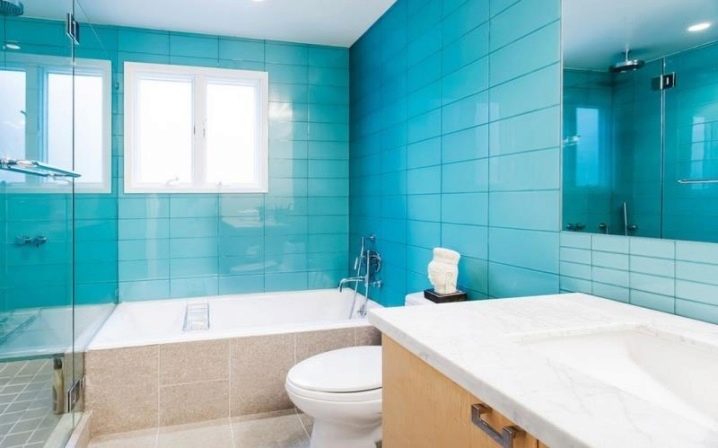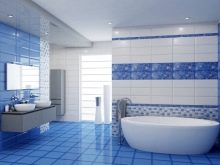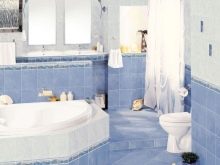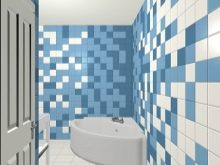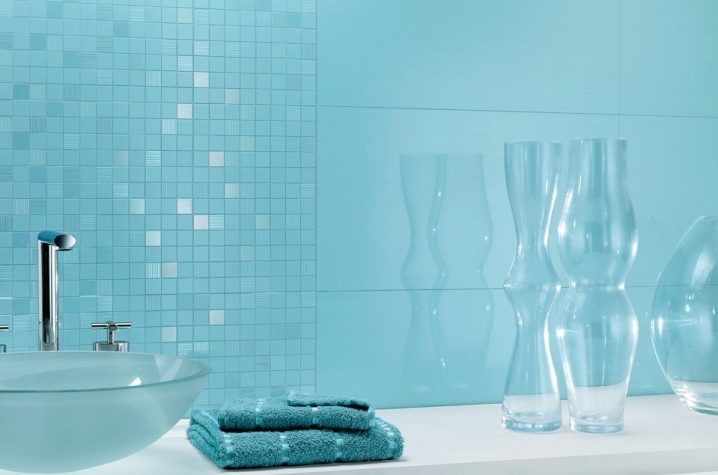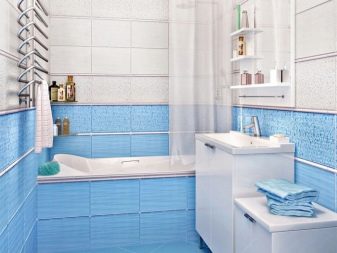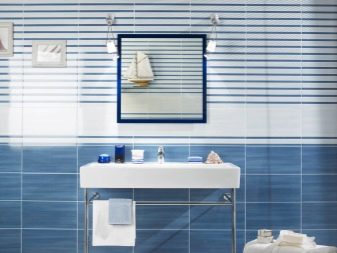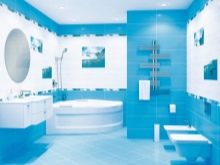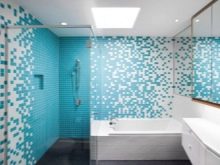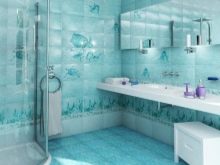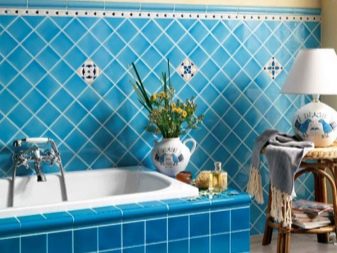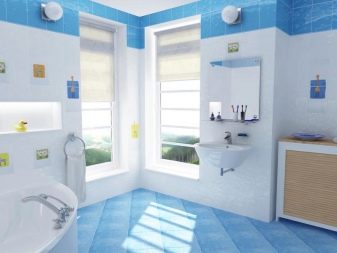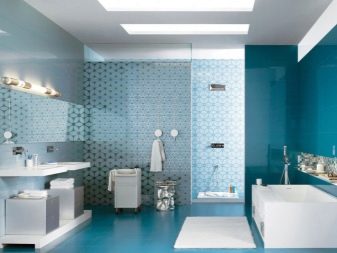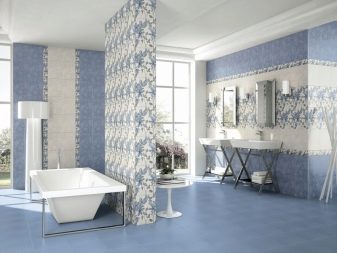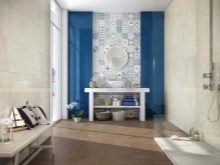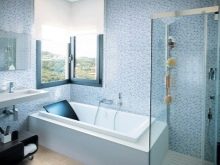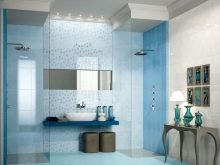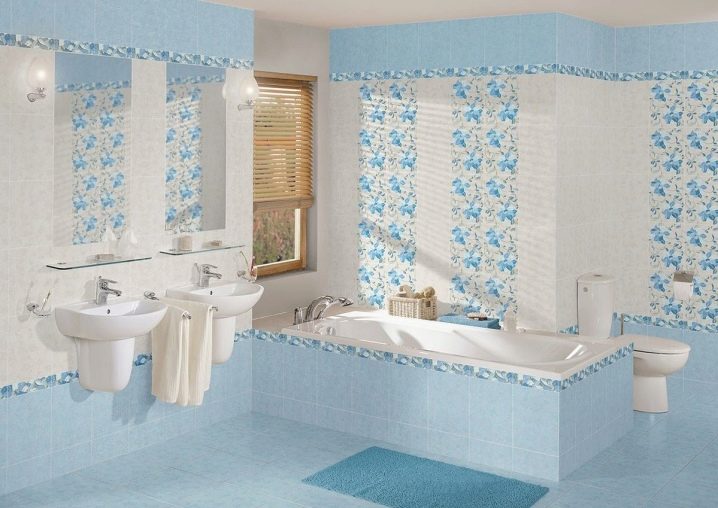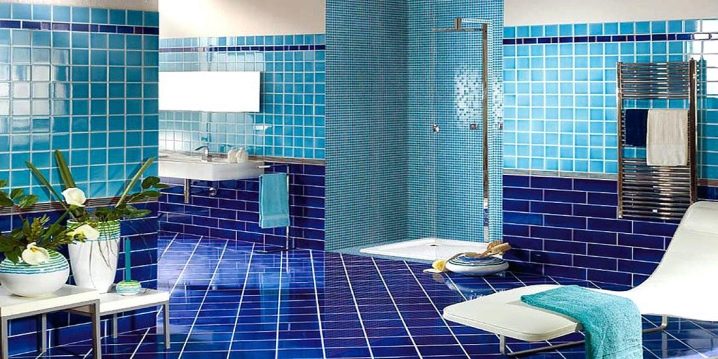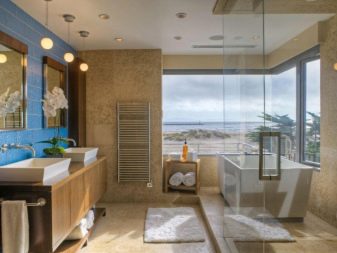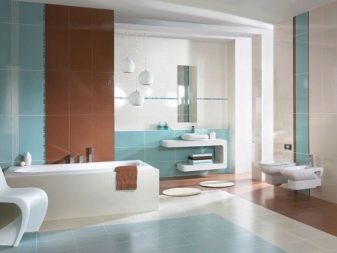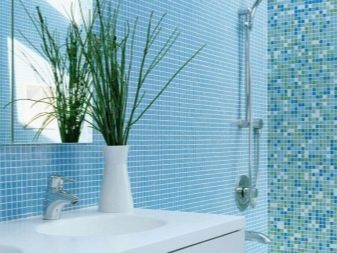Blue tile in bathroom interior design

Blue tile is very popular, because such a finishing material always looks very beautiful, gives the interior softness, tenderness, lightness. Blue is a nice color, it never annoys. Tiled coverings of such shades are particularly well suited for the interior design of a bathroom.
Color features
Blue tiles will be very well combined with light fixtures in the bathroom. In the morning, people need to wake up as soon as possible, to prepare for working days, and blue shades invigorate.
There are other features of this color:
- the use of blue tile coatings is a very good option for small rooms, because the “heavenly” shades visually expand the space;
- this color creates a feeling of peace and comfort;
- It is able to lower blood pressure, soothe, relieve irritation and stress.
Sometimes blue tile creates a feeling of lack of comfort, coldness (especially in cases where the shade is pastel). To complement, soften an existing design, you can use a warmer color. If the homeowner is only going to carry out finishing work and wants to avoid the feeling of coldness, then he should opt for a matte, and not on a glossy blue finish.
Possible combinations
Monochrome blue surfaces can look quite nice, but such rooms cause associations with laboratories. To avoid such similarities, you can use additional decorative elements, patterns. If you choose a blue tile, it is not recommended to purchase for the bathroom other products of the same color: curtains, brush holders, towels and other accessories. It is better to dilute the interior with other tones, otherwise all the objects in the room will merge with the walls.
Blue ceramic tiles are well suited for ethnic motifs, art deco, hi-tech, classic style.It can be combined with plastic, glass, metal or wooden interior elements.
The following options are suitable for a bathroom.
- The white surface at the top of the wall and the blue tile at the bottom. Blue with white - one of the most common options. Tiled coverings can be either decorated with patterns or patterns, or plain.
- Mosaic. This tile visually makes the room bigger. A combination of turquoise mosaic and white tile looks great. Another option is suitable for a bathroom - monochrome gradation. It is necessary to make the transition from the ceiling (light blue tile) to the floor (dark blue tone).
- The combination of tile materials blue and brown pieces of furniture. Such an interior looks expensive and spectacular. In this case, you should stop the choice on the tile without drawings - it should be textured or matte.
- Maritime theme. This style is very suitable for a bathroom. To create a marine design, you need to use the sea green and blue shades. Perhaps the use of bright accents - so you can "revive" the interior.
How to choose?
Do not choose wall tiles for floors. The tile on the floor must be rough and matte - otherwise the surface will be slippery. Rough coatings are harder to care for, but first of all you need to think about safety. For walls, you can choose materials that are less resistant to abrasion - such are glossy coatings. Glossy products are resistant to the effects of cosmetics and cleaning products, they are fairly easy to care for (the main thing is to do it regularly). Mosaic tiles are suitable for both the floor and the walls, because it is durable and it is impossible to slip on it.
Saturated deep shades of tiles will make the interior luxurious, unique. It should be borne in mind that this design option is only suitable for fairly spacious and well-lit rooms. For large and medium-sized bathrooms, you can choose a fairly large tile without patterns, having a textured or matte surface.
Recommendations for use
Laying tile coatings can be a variety of ways.
The most popular options are:
- Can be used for floor and walls tiled products of the same size and design. However, this option is not suitable if a person prefers to use accents and avoid monotony.
- Some prefer to zone a room using several varieties of tile materials. You can, for example, decorate the area near the sink and bath with ordinary coatings, and highlight the shower using mosaic tiles.
- A very common version of the design of the walls - "belt". Over the entire surface, identical tile surfaces are laid (most often they have a rectangular shape), and horizontally (usually in the middle) runs a contrasting tile.
- Using the classic white color, you can visually expand the space. One third of the wall should be made white, two thirds of the surface should be decorated with blue tile coatings.
- “Brickwork” from blue and white tiles looks very interesting. Some draw only one wall in this way, making the other surfaces uniform. For such a design is better to choose glossy tile coatings.
- To dilute the interior, you can finish one wall (behind a shower or bath) with glossy tile materials of various shades of blue. You can use products with drawings and patterns.
- If you want to visually make the walls taller, you can lay the rectangular blue tile vertically, and having completed the facing horizontally, the room will visually lengthen, while the walls will appear wider.
Bathroom should not be cluttered with furniture or decor, regardless of the size and shade of the tile. Making the room blue tiles, you need to rely on their artistic flair and take into account the recommendations of experts - in this case, the homeowner will not be disappointed with the result.
Design options
Light blue shades make the bathroom cozy.
To diversify the design, you can use not only blue, but also other colors, for example, blue.
Brown items in the blue bathroom add some chic to the interior.
Blue tiled surfaces will perfectly fit into the original interior in a modern style.
How to lay tile in the bathroom, you will learn in the next video.
